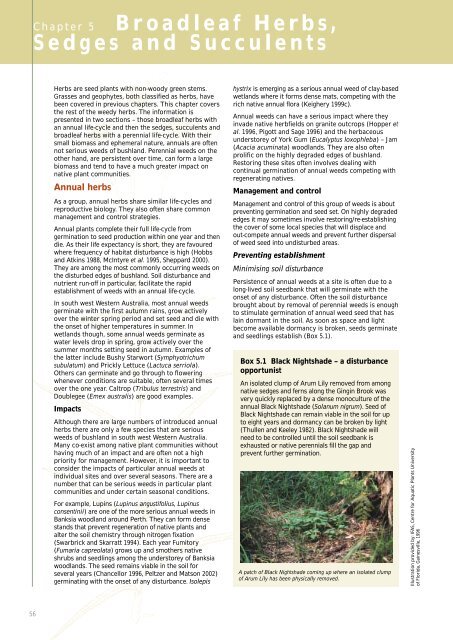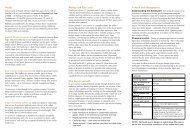Bushland Weeds Manual - Environmental Weeds Action Network
Bushland Weeds Manual - Environmental Weeds Action Network
Bushland Weeds Manual - Environmental Weeds Action Network
You also want an ePaper? Increase the reach of your titles
YUMPU automatically turns print PDFs into web optimized ePapers that Google loves.
Chapter 5 Broadleaf Herbs,<br />
Sedges and Succulents<br />
56<br />
Herbs are seed plants with non-woody green stems.<br />
Grasses and geophytes, both classified as herbs, have<br />
been covered in previous chapters. This chapter covers<br />
the rest of the weedy herbs. The information is<br />
presented in two sections – those broadleaf herbs with<br />
an annual life-cycle and then the sedges, succulents and<br />
broadleaf herbs with a perennial life-cycle. With their<br />
small biomass and ephemeral nature, annuals are often<br />
not serious weeds of bushland. Perennial weeds on the<br />
other hand, are persistent over time, can form a large<br />
biomass and tend to have a much greater impact on<br />
native plant communities.<br />
Annual herbs<br />
As a group, annual herbs share similar life-cycles and<br />
reproductive biology. They also often share common<br />
management and control strategies.<br />
Annual plants complete their full life-cycle from<br />
germination to seed production within one year and then<br />
die. As their life expectancy is short, they are favoured<br />
where frequency of habitat disturbance is high (Hobbs<br />
and Atkins 1988, McIntyre et al. 1995, Sheppard 2000).<br />
They are among the most commonly occurring weeds on<br />
the disturbed edges of bushland. Soil disturbance and<br />
nutrient run-off in particular, facilitate the rapid<br />
establishment of weeds with an annual life-cycle.<br />
In south west Western Australia, most annual weeds<br />
germinate with the first autumn rains, grow actively<br />
over the winter spring period and set seed and die with<br />
the onset of higher temperatures in summer. In<br />
wetlands though, some annual weeds germinate as<br />
water levels drop in spring, grow actively over the<br />
summer months setting seed in autumn. Examples of<br />
the latter include Bushy Starwort (Symphyotrichum<br />
subulatum) and Prickly Lettuce (Lactuca serriola).<br />
Others can germinate and go through to flowering<br />
whenever conditions are suitable, often several times<br />
over the one year. Caltrop (Tribulus terrestris) and<br />
Doublegee (Emex australis) are good examples.<br />
Impacts<br />
Although there are large numbers of introduced annual<br />
herbs there are only a few species that are serious<br />
weeds of bushland in south west Western Australia.<br />
Many co-exist among native plant communities without<br />
having much of an impact and are often not a high<br />
priority for management. However, it is important to<br />
consider the impacts of particular annual weeds at<br />
individual sites and over several seasons. There are a<br />
number that can be serious weeds in particular plant<br />
communities and under certain seasonal conditions.<br />
For example, Lupins (Lupinus angustifolius, Lupinus<br />
consentinii) are one of the more serious annual weeds in<br />
Banksia woodland around Perth. They can form dense<br />
stands that prevent regeneration of native plants and<br />
alter the soil chemistry through nitrogen fixation<br />
(Swarbrick and Skarratt 1994). Each year Fumitory<br />
(Fumaria capreolata) grows up and smothers native<br />
shrubs and seedlings among the understorey of Banksia<br />
woodlands. The seed remains viable in the soil for<br />
several years (Chancellor 1996, Peltzer and Matson 2002)<br />
germinating with the onset of any disturbance. Isolepis<br />
hystrix is emerging as a serious annual weed of clay-based<br />
wetlands where it forms dense mats, competing with the<br />
rich native annual flora (Keighery 1999c).<br />
Annual weeds can have a serious impact where they<br />
invade native herbfields on granite outcrops (Hopper et<br />
al. 1996, Pigott and Sage 1996) and the herbaceous<br />
understorey of York Gum (Eucalyptus loxophleba) – Jam<br />
(Acacia acuminata) woodlands. They are also often<br />
prolific on the highly degraded edges of bushland.<br />
Restoring these sites often involves dealing with<br />
continual germination of annual weeds competing with<br />
regenerating natives.<br />
Management and control<br />
Management and control of this group of weeds is about<br />
preventing germination and seed set. On highly degraded<br />
edges it may sometimes involve restoring/re-establishing<br />
the cover of some local species that will displace and<br />
out-compete annual weeds and prevent further dispersal<br />
of weed seed into undisturbed areas.<br />
Preventing establishment<br />
Minimising soil disturbance<br />
Persistence of annual weeds at a site is often due to a<br />
long-lived soil seedbank that will germinate with the<br />
onset of any disturbance. Often the soil disturbance<br />
brought about by removal of perennial weeds is enough<br />
to stimulate germination of annual weed seed that has<br />
lain dormant in the soil. As soon as space and light<br />
become available dormancy is broken, seeds germinate<br />
and seedlings establish (Box 5.1).<br />
Box 5.1 Black Nightshade – a disturbance<br />
opportunist<br />
An isolated clump of Arum Lily removed from among<br />
native sedges and ferns along the Gingin Brook was<br />
very quickly replaced by a dense monoculture of the<br />
annual Black Nightshade (Solanum nigrum). Seed of<br />
Black Nightshade can remain viable in the soil for up<br />
to eight years and dormancy can be broken by light<br />
(Thullen and Keeley 1982). Black Nightshade will<br />
need to be controlled until the soil seedbank is<br />
exhausted or native perennials fill the gap and<br />
prevent further germination.<br />
A patch of Black Nightshade coming up where an isolated clump<br />
of Arum Lily has been physically removed.<br />
Illustration provided by: IFAS, Centre for Aquatic Plants University<br />
of Florida, Gainesville, 1996



